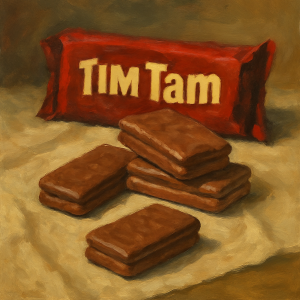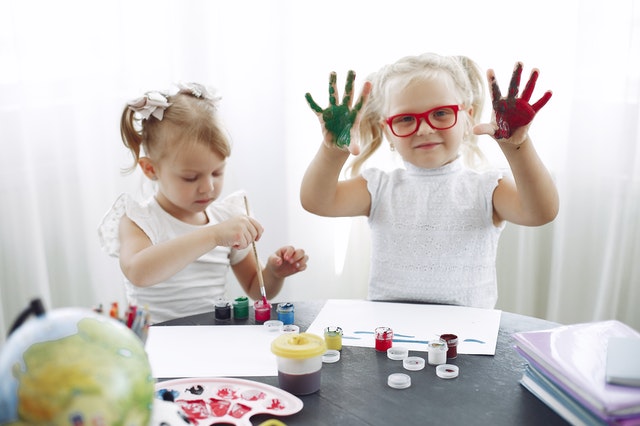 In Australian homes, a pack of Tim Tams is more than just a snack. It’s comfort, nostalgia, and sometimes even a peace offering. But for a growing number of artists, it’s also a subject of creative expression. Across painting, photography, and pop art, iconic Aussie treats like Tim Tams, Vegemite, and Shapes are making their way from kitchen pantries into galleries and Instagram feeds—reminding us of the food groceries Aussie expats miss once when they’re far from home.
In Australian homes, a pack of Tim Tams is more than just a snack. It’s comfort, nostalgia, and sometimes even a peace offering. But for a growing number of artists, it’s also a subject of creative expression. Across painting, photography, and pop art, iconic Aussie treats like Tim Tams, Vegemite, and Shapes are making their way from kitchen pantries into galleries and Instagram feeds—reminding us of the food groceries Aussie expats miss once when they’re far from home.
This trend, often described as snack-based still life or pop-inspired realism, plays with ideas of memory, culture, and identity. It’s modern, playful, and deeply rooted in everyday Australian life.
Snacks as Symbols
Still life painting has always been about more than just objects. From 17th-century Dutch painters arranging fruit to convey a message about wealth or mortality, to Andy Warhol transforming soup cans into commentary on consumerism, everyday items have long served as stand-ins for larger ideas.
In Australia, snacks like Tim Tams have become cultural icons. They’re immediately recognizable, affordable, and shared across generations. So it’s no surprise they’re showing up in art that aims to connect with a broad audience. A Tim Tam on canvas isn’t just a chocolate biscuit. It’s a symbol of childhood, of home, of that 3 p.m. sugar craving most Aussies know well.
Pop Art Meets the Pantry
Pop art has had a huge influence on the current wave of snack-inspired work. Artists like Ben Frost have been riffing on consumer packaging for years, reworking cereal boxes and candy wrappers with a cheeky, satirical edge. In his pieces, you’ll often see well-known snack branding mashed up with pop culture references. It’s an echo of Warhol, but with an Aussie flavour.
Other artists lean into nostalgia. Painter Katherine Brickman, for example, creates bright, flat-lay compositions that resemble the snack aisle exploding across the canvas. Shapes, Paddle Pops, and, of course, Tim Tams are carefully arranged alongside school stationery or retro toys. The result gives viewers an instant flashback to their childhood lunchbox days.
Photography with a Bite
It’s not just traditional painting that’s taking cues from the snack drawer. Photographers are also using Aussie treats as props or even centrepieces in their work. Some aim for humour, with carefully staged scenes of melting Golden Gaytimes or Vegemite toast “portraits.” Others use snacks in a more abstract or stylised way, framing them with high-contrast lighting or unusual backdrops to highlight their texture, colour, and shape.
One notable example is photographer Rachel Knepfer’s “Shelf Life” series, which captures snack packaging in stark, museum-like conditions. A lone Tim Tam, illuminated like a rare artifact, forces viewers to reconsider the object. How we consume it, why it matters, and what it says about us.
Why Tim Tams?
So, why do Tim Tams appear so frequently? Maybe it’s because they strike the right balance of familiarity and visual appeal. Their glossy chocolate coating and neat rectangular form make them surprisingly photogenic. But it’s also the emotional link. Everyone has a story with a Tim Tam—burning through a whole sleeve during a breakup, sharing one with a friend, or learning the infamous “Tim Tam slam.”
These small, relatable moments are what many modern artists want to capture. In an art world that sometimes feels distant or elite, a Tim Tam painting is immediate. It says, “You know this. You’ve tasted this. This is part of your world.”
From Instagram to the Gallery
A significant part of this movement is taking place online. Artists and designers are sharing snack-inspired art on Instagram, Etsy, and TikTok. Many blend styles or mix traditional mediums with digital tools. Some even create GIFs and animations featuring dancing Tim Tams or surreal snack dreamscapes.
This digital-first approach has helped the genre gain momentum and reach new audiences. While some artists display their work in galleries, many are building followings and selling prints directly to fans who want a piece of Australian pop culture on their walls.
It’s not always ironic, either. While pop art often critiques consumerism, much of this work comes from a place of affection. The tone is usually light, colourful, and celebratory. It’s about turning the ordinary into something worth noticing.
A New Kind of National Identity
At its core, the rise of snack-inspired art in Australia is about finding beauty and meaning in the mundane. It reflects a culture that doesn’t take itself too seriously, that celebrates small pleasures, and that can laugh at (and with) its own habits.
Whether it’s a hyper-realistic painting of an Arnott’s Family Assortment or a moody photo of a crushed Twisties bag, these works invite us to see everyday Aussie life through a different lens. They remind us that art isn’t always about grandeur. Sometimes, it’s just about a Tim Tam on a plate and everything that comes with it.
Continue reading




 Every legal case begins with a story. A family facing deportation, a business owner tangled in a contract dispute, or an individual seeking justice after a wrong, these are not just cases but deeply human narratives. In Texas, lawyers approach these challenges like artists, blending empathy, strategy, and legal expertise to craft outcomes that resonate like a masterpiece. The process mirrors the creation of art, where raw emotion and complexity are shaped into something meaningful, powerful, and enduring.
Every legal case begins with a story. A family facing deportation, a business owner tangled in a contract dispute, or an individual seeking justice after a wrong, these are not just cases but deeply human narratives. In Texas, lawyers approach these challenges like artists, blending empathy, strategy, and legal expertise to craft outcomes that resonate like a masterpiece. The process mirrors the creation of art, where raw emotion and complexity are shaped into something meaningful, powerful, and enduring. Numerous places use the tiered pricing: simple access, that of VIP-rooms, bottle service, or private suites. This hierarchy is similar to the editions of art (standard, limited, deluxe). Customers do not only spend on the experience but exclusivity, ambience or closeness to performers. The very price already is an element of the artistic design of experience.
Numerous places use the tiered pricing: simple access, that of VIP-rooms, bottle service, or private suites. This hierarchy is similar to the editions of art (standard, limited, deluxe). Customers do not only spend on the experience but exclusivity, ambience or closeness to performers. The very price already is an element of the artistic design of experience. The fact that Gangnam is a trendsetter, a district with cutting edge reputation, makes it an appropriate place to make this hybrid start. The location is a crusting of street culture, night life, performance art, and self-expression. By so doing, it captures a charged moment, of the merging of entertainment, identity, and spectacle of creativity.
The fact that Gangnam is a trendsetter, a district with cutting edge reputation, makes it an appropriate place to make this hybrid start. The location is a crusting of street culture, night life, performance art, and self-expression. By so doing, it captures a charged moment, of the merging of entertainment, identity, and spectacle of creativity. In Australian homes, a pack of Tim Tams is more than just a snack. It’s comfort, nostalgia, and sometimes even a peace offering. But for a growing number of artists, it’s also a subject of creative expression. Across
In Australian homes, a pack of Tim Tams is more than just a snack. It’s comfort, nostalgia, and sometimes even a peace offering. But for a growing number of artists, it’s also a subject of creative expression. Across 




 The possibilities are endless, really. Consider all possible uses for this ingenious lighting system, and then some. Some suggestions are as follows:
The possibilities are endless, really. Consider all possible uses for this ingenious lighting system, and then some. Some suggestions are as follows:




 “I wanted to form a section of art, instead of a building,” said French architect Jean Nouvel on his latest creation, the Louvre national capital. He has undoubtedly achieved this by marrying the old with the new, culture with technology – to make a vibrant community space. This neighborhood spirit springs out of this huge fettered dome within the desert, surrounded by a cluster of white cubes, pavilions, trickling pools, and serene walkways. Inside, the sweetness and inspiration of works by world-renowned artists throughout history will be appreciated by physical visitors and virtually via an app.
“I wanted to form a section of art, instead of a building,” said French architect Jean Nouvel on his latest creation, the Louvre national capital. He has undoubtedly achieved this by marrying the old with the new, culture with technology – to make a vibrant community space. This neighborhood spirit springs out of this huge fettered dome within the desert, surrounded by a cluster of white cubes, pavilions, trickling pools, and serene walkways. Inside, the sweetness and inspiration of works by world-renowned artists throughout history will be appreciated by physical visitors and virtually via an app.

 Most people don’t know much about the towing profession or tow trucks. Is there anything interesting about tow truck or the towing industry? It’s absolutely unpleasant situation when your car breaks down and you would like a tow truck service to either
Most people don’t know much about the towing profession or tow trucks. Is there anything interesting about tow truck or the towing industry? It’s absolutely unpleasant situation when your car breaks down and you would like a tow truck service to either 







 The categories of
The categories of  You may be amazed to understand the arts and wellness have over 100 decades of the venture. Literary art, music, dancing, creative writing, dramatic play, and theatre are used for years to boost the individual knowledge in hospitals, mental health care centers, senior care centers and emergency rooms, and occupational therapy practices, in healthcare, and much more. Wherever people are otherwise or in an emergency — wellbeing — actions that are imaginative are located.
You may be amazed to understand the arts and wellness have over 100 decades of the venture. Literary art, music, dancing, creative writing, dramatic play, and theatre are used for years to boost the individual knowledge in hospitals, mental health care centers, senior care centers and emergency rooms, and occupational therapy practices, in healthcare, and much more. Wherever people are otherwise or in an emergency — wellbeing — actions that are imaginative are located. Art is a selection of activities completed artifacts — artworks — which express the author ability, and are meant to be valued for their beauty or power, or participated in producing visual, sensory.
Art is a selection of activities completed artifacts — artworks — which express the author ability, and are meant to be valued for their beauty or power, or participated in producing visual, sensory. Art is a selection of activities completed artifacts — artworks — which express the author’s ability, and are meant to be valued for their beauty or power, or participated in producing visual, sensory.
Art is a selection of activities completed artifacts — artworks — which express the author’s ability, and are meant to be valued for their beauty or power, or participated in producing visual, sensory.
 More often than not, what the majority of homeowners unquestionably love concerning their home are the vistas and the location itself. In actual fact, a lot of homeowners can tolerate to live or put up with a smaller home if it implies having a great panoramic view and to provide this view, windows are very crucial. Every single space in your home can gain from windows that are stunning. Additionally, there is an array of designs to select from that will most likely suit your styles. Hence, if you have been searching for means to lighten up your interiors, have a look at your windows. Check out affordableblinds.cominexpensive cellular blinds.
More often than not, what the majority of homeowners unquestionably love concerning their home are the vistas and the location itself. In actual fact, a lot of homeowners can tolerate to live or put up with a smaller home if it implies having a great panoramic view and to provide this view, windows are very crucial. Every single space in your home can gain from windows that are stunning. Additionally, there is an array of designs to select from that will most likely suit your styles. Hence, if you have been searching for means to lighten up your interiors, have a look at your windows. Check out affordableblinds.cominexpensive cellular blinds.

 Korean massage parlors craft spaces that soothe the senses and elevate relaxation to an art form. These havens blend thoughtful interior design, ambient lighting, and curated visual elements to create an atmosphere of luxury and calm. High-end spas across South Korea transform simple rooms into sanctuaries, offering a retreat from the chaos of daily life. Every detail, from the texture of the walls to the flicker of a candle, plays a role in this immersive experience. But how do these spaces achieve such harmony? Let’s explore the elements that make these parlors a masterpiece of design and healing.
Korean massage parlors craft spaces that soothe the senses and elevate relaxation to an art form. These havens blend thoughtful interior design, ambient lighting, and curated visual elements to create an atmosphere of luxury and calm. High-end spas across South Korea transform simple rooms into sanctuaries, offering a retreat from the chaos of daily life. Every detail, from the texture of the walls to the flicker of a candle, plays a role in this immersive experience. But how do these spaces achieve such harmony? Let’s explore the elements that make these parlors a masterpiece of design and healing. Car owners know the value of keeping their vehicles in top shape. One simple tool that helps with this is a car cover or top shield. It protects against dust, rain, sun, and scratches. But car covers today are more than just practical—they can also be a form of art.
Car owners know the value of keeping their vehicles in top shape. One simple tool that helps with this is a car cover or top shield. It protects against dust, rain, sun, and scratches. But car covers today are more than just practical—they can also be a form of art.



 Moving a concert grand piano is a task that requires great care, expertise, and the right equipment. These pianos are not only expensive but also very delicate, making their safe transport a top priority. This article explores the unique challenges and solutions involved in moving concert grand pianos of
Moving a concert grand piano is a task that requires great care, expertise, and the right equipment. These pianos are not only expensive but also very delicate, making their safe transport a top priority. This article explores the unique challenges and solutions involved in moving concert grand pianos of 
 Yachts are often seen as the pinnacle of luxury and wealth, symbols of freedom on the waves. Yet, they are more than just vessels for sailing; they are also canvases for artistic expression. This blend of art and engineering transforms yachts into moving masterpieces, showcasing personal style and cutting-edge design.
Yachts are often seen as the pinnacle of luxury and wealth, symbols of freedom on the waves. Yet, they are more than just vessels for sailing; they are also canvases for artistic expression. This blend of art and engineering transforms yachts into moving masterpieces, showcasing personal style and cutting-edge design. Understanding the Essentials of Night Security Cameras
Understanding the Essentials of Night Security Cameras The Aesthetic Edge: Night Security Cameras Art
The Aesthetic Edge: Night Security Cameras Art The quest for innovative materials that can transform spaces and evoke emotions is perpetual. Among the myriad of options available to artists, tempered glass panels have emerged as a captivating medium. Known for their strength and safety, these panels are not only practical but also offer a unique aesthetic potential that artists are beginning to tap into.
The quest for innovative materials that can transform spaces and evoke emotions is perpetual. Among the myriad of options available to artists, tempered glass panels have emerged as a captivating medium. Known for their strength and safety, these panels are not only practical but also offer a unique aesthetic potential that artists are beginning to tap into.






